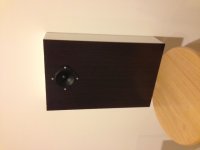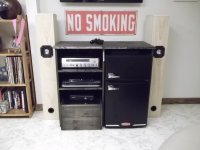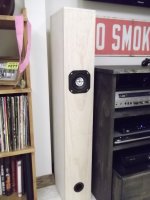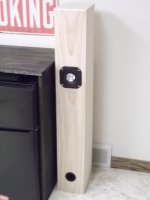Oh, the material... Yes, the back and side walls are FC. I wouldn't characterize FC as lossy from what I have heard in the 10 different FC speakers designs I have made. As far as its ability to contain the air flow to produce bass, it all seems to be there. It may have the effect of being semi-transparent to higher frequencies radiating through - like a guitar body - but that has not been a problem. In this particular design with the baffle made of chip board, this should be even less of a problem.
Oh, the material... Yes, the back and side walls are FC. I wouldn't characterize FC as lossy from what I have heard in the 10 different FC speakers designs I have made. As far as its ability to contain the air flow to produce bass, it all seems to be there. It may have the effect of being semi-transparent to higher frequencies radiating through - like a guitar body - but that has not been a problem. In this particular design with the baffle made of chip board, this should be even less of a problem.
There might be some losses due to panel flex.
IG
Compact Wall-Mount MLTL Design - Update: AkAbak model
I just figured out how to model a MLTL using AkAbak with assistance from Don Hills. I entered the design for my latest Vifa folded AMLTL and got a pretty reasonable result for the frequency response prediction. Figuring out how to deal with the damping will still be a challenge and is an on-going learning process for me. I guess it is no longer "accidental" as the design seems to indicate some good bass down to ~50 Hz. What is neat is that the floor and wall are modeled here because being a wall mount there was no baffle step loss which clearly showed up when I displaced the speaker cabinet away from the wall. The downward firing port right next to wall did not seem to hurt.
Thanks for all your help Don! 🙂 AkAbak is very powerful. You can add passive or active filters, crossovers, op-amps, tweeters, etc. Looks like a fantastic tool for speaker design. Kind of hard to get past the learning curve (which I have not yet reached).
I just figured out how to model a MLTL using AkAbak with assistance from Don Hills. I entered the design for my latest Vifa folded AMLTL and got a pretty reasonable result for the frequency response prediction. Figuring out how to deal with the damping will still be a challenge and is an on-going learning process for me. I guess it is no longer "accidental" as the design seems to indicate some good bass down to ~50 Hz. What is neat is that the floor and wall are modeled here because being a wall mount there was no baffle step loss which clearly showed up when I displaced the speaker cabinet away from the wall. The downward firing port right next to wall did not seem to hurt.
Thanks for all your help Don! 🙂 AkAbak is very powerful. You can add passive or active filters, crossovers, op-amps, tweeters, etc. Looks like a fantastic tool for speaker design. Kind of hard to get past the learning curve (which I have not yet reached).
Attachments
Well X i think I found a start to a MLTL with a 6.5" Maybe 2 of the 4ohm in a bipole MLTL. This thread has good start. 60 inch line. I'll try and draw a box up tonight and I will let you critique if you graciously would.
I know I know in the long run it will have to turn into a 2way with a bit of tweeter help.
http://www.diyaudio.com/forums/multi-way/227666-tl-silver-flute-6-5-a.html
The design by GM is an MJK simulation so is good. The simple way to make it bipole is to double to volume and double the port. Since internal dims are 6 x 9.5 in make it 12 in deep x 9.5 wide with two ports one front one back.
I'm going to try and not do it the simple way. haha. I'm going to try and fold it so the maximum height is 48"
Ryan,
It will be interesting to see how you fold it. Front to back or side to side. You could fold it like how I did my last wallmount a few posts back: up down then sideways in such a way that driver is at top middle. You will have 12 in deep x 19 in wide x 30 in tall speaker with bipoles mounted at top in such a way that they are at 1/3 distance from end. I would probably go with slightly longer and larger dia vents. Or stick with 2 in dia, just seems a little small for a 6.5 in driver. That will take a recalculation though, and could be done with the AMLTL method or with AkAbak.
X
It will be interesting to see how you fold it. Front to back or side to side. You could fold it like how I did my last wallmount a few posts back: up down then sideways in such a way that driver is at top middle. You will have 12 in deep x 19 in wide x 30 in tall speaker with bipoles mounted at top in such a way that they are at 1/3 distance from end. I would probably go with slightly longer and larger dia vents. Or stick with 2 in dia, just seems a little small for a 6.5 in driver. That will take a recalculation though, and could be done with the AMLTL method or with AkAbak.
X
Last edited:
Hi xrk971!
Cheers!!
Gost,
Did you ever build those 8 in horn speakers? Or still looking for ideas?
Like the project with BG-20 VISATON, work in this area.Gost,
Did you ever build those 8 in horn speakers? Or still looking for ideas?
Gost,
You should build the BG20 bipole - it will be a super efficient monster of a MLTL. Let me know if you need a sketch or drawing to help you.
X
You should build the BG20 bipole - it will be a super efficient monster of a MLTL. Let me know if you need a sketch or drawing to help you.
X
Compact Vifa MLTL build completed
I Just finished the new speakers. Have not had too much time to listen to them but there is a good deep bass punch to them. I may have to play with stuffing adjustment. They sound real nice so far. Very compact almost desktop size. Sorry about the rotated photo - it was vertical when I uploaded it. This was a super simple build.
I Just finished the new speakers. Have not had too much time to listen to them but there is a good deep bass punch to them. I may have to play with stuffing adjustment. They sound real nice so far. Very compact almost desktop size. Sorry about the rotated photo - it was vertical when I uploaded it. This was a super simple build.
Attachments
Last edited:
I updated the first post to show links to now 5 known examples of successful builds using the Accidental MLTL or AMLTL technique. I have since figured out how to model MLTL's in AkAbak, so this technique is only used as a starting point to estimate an initial CSA and vent dimensions from which to start tuning in the real simulation.
Well X, I finally finished the Monacor sp50x MLTL's 48 t by 9 d by 6 w. They sound very good! I'll get some photos up tomorrow.
Thanks again.
Thanks again.
Ryan,
Congratulations on another set of speakers. 🙂 Whose room do these go in? Looking forward to the pics and more detailed listening impressions.

Congratulations on another set of speakers. 🙂 Whose room do these go in? Looking forward to the pics and more detailed listening impressions.

I'll get them posted tonight. Had to get the street bike ready for a trip this weekend and then I had golf tourney last nite. Pics will be up tonight.
monacor sp50x mltl
Well here they are. The enclosures replaced a set that were strictly bass reflex cabinets. These sound so much better. Lower extension and has a fuller low-mid.
Can definitely listen without sub help.
I haven't decided how to finish them. The old ones were stained black to match the mini entertainment center. I'm leaning that way but I do like the natural look also.
Thanks again X for all your help.
Well here they are. The enclosures replaced a set that were strictly bass reflex cabinets. These sound so much better. Lower extension and has a fuller low-mid.
Can definitely listen without sub help.
I haven't decided how to finish them. The old ones were stained black to match the mini entertainment center. I'm leaning that way but I do like the natural look also.
Thanks again X for all your help.
Attachments
Very nice work Ryan! Glad they sound good. 🙂
You have great wood working skills, very polished.
You have great wood working skills, very polished.
- Home
- Loudspeakers
- Full Range
- Accidental MLTL Technique




